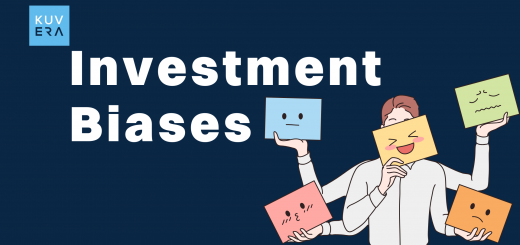
About the author: Apurv Jain is a visiting researcher at Harvard Business School where he is working on using alternate data sources (Big Data) and artificial intelligence (AI) for investing. He is also an advisor to Kuvera senior management.
To do nothing at all is the most difficult thing in the world, the most difficult and the most intellectual.
When Oscar Wilde said that he was not referring to investing, but it applies equally well to investing, especially in volatile periods.
With various stock indices down (NIFTY down ~11%, NIFTY SmallCap down ~30%) and the accompanying news cycle of gloom and doom, there is a natural tendency to “want to do something“- which usually means giving into fear and selling available investments or to greed and buying more.
However, academic and practitioner research reveals two major things –
1/ Transacting less is better for your financial health
2/ Investors extrapolate past returns into the future and buy into funds that have “worked” and sell out of funds that have “not worked.”
Based on a research paper titled “Expectations of Returns and Expected Returns”, by Prof Shleifer and Prof Greenwood, both at Harvard University, we come to three conclusions on investor behaviour and how past returns of funds and indices affect investors decision making.
1/ Most investors agree on expected returns:
It doesn’t matter how you look at the investing population, we all tend to come to similar conclusions on expected returns. For example, one would think that CFO’s of corporations would have a better idea on future returns (as a proxy of real economy) than average investors. The reality could not be more different. Most investor surveys show similar expectations regardless of the population being surveyed.

Figure 1: Most investor surveys show similar expectations regardless of the population being surveyed. Source: Greenwood and Shleifer (2014)
2/ We extrapolate based on the past:
The measures of investor expectations are positively related with past stock market returns as well as with the level of the stock market. If the past 3-5 years returns are high, we all naively expect the next 3-5 year returns to be high as well. No wonder more retail investment accounts are opened at the last stages of a market rally when the past 3-5 year returns look really good, then at the beginning.

Figure 2: Investors extrapolate based on the past to form return expectations. Source Greenwood and Shleifer (2014).
3/ We invest based on our expectations.
Funds flow into equity mutual funds is highly correlated to investor expectations. Thus weak recent past performance will lead to negative expectations for future returns and the withdrawing of money from the funds. And strong recent past returns will lead to positive expectations of future returns and thus more buying into funds that did well.

Figure 3: Investors act based on their return expectations in form of putting or withdrawing money from equity mutual funds. Source Greenwood and Shleifer (2014).
This would all still be fine if the resulting investments worked out. However, as this chart from J.P. Morgan shows that average investors are quite bad at guessing the direction of returns. So when we expect higher returns (and have invested based on that belief) the actual returns tend to be low and when we have withdrawn money based on our low sentiment and we expect low future returns, the returns tend to be higher. This is also consistent with the negative correlation between the actual returns and the expectations of those returns formed by Greenwood and Shleifer.

Figure 4: Investor expectations and future performance tend to be negatively related! Source: JP Morgan Asset Management, Guide to the Markets 1Q 2017.
So what should we do?
1/ Be sceptical of a group of investors that claim to know better – on Twitter, on TV or anywhere else. Market timing is not easy and most of us have similar behavioural biases.
2/ Understand that being reactive and chasing returns tends to hurt more than it helps. So do not blindly extrapolate: Always remember “Past performance is no guarantee of future results.”
3/ Use discipline to lower the impact of sentiment on investing. What makes SIP such a powerful tool of investing is that it matches your salary income to your investing schedule and enforces that discipline. It also reduces the cognitive strain of deciding when to invest and when to withdraw.
But does this apply to the Indian stock market?
Astute readers will point out that the studies cited were not conducted on the Indian markets and question the validity of applying them here. We agree with these readers and would respond that while we do not know if the Indian markets will behave exactly the same, but human investing behaviour is more likely to at least rhyme if not repeat itself. We would also point to several academic studies that find market behaviour across the world to be more similar than dissimilar. One such study is “Value and Momentum Everywhere” (Asness et al. , 2013) that finds that the same investing strategies or factors such as value and momentum that were initially tested in the United States on individual stocks have similar performance across multiple asset classes such as equities, bonds, currencies and commodity futures, and across countries such as the United Kingdom, continental Europe, and Japan.
We will explore more behavioural biases in upcoming posts and why the returns generated by the average investors may not be close to the index returns – in part due to our impulse to time re-actively.
So practice doing this very important and difficult thing – manage your expectations and do nothing.
References
- Greenwood, Robin, and Andrei Shleifer. 2014. “Expectations of Returns and Expected Returns.” Review of Financial Studies 27 (3): 714-746.
- JP Morgan Asset Management, Guide to the Markets 1Q 2017.
- Asness, Clifford S., Tobias J. Moskowitz, and Lasse Heje Pedersen. “Value and Momentum Everywhere.” The Journal of Finance Vol. 68, No. 3 (June 2013), pp. 929-985
Start investing through a platform that brings goal planning and investing to your fingertips. Visit kuvera.in to discover Direct Plans and start investing today.
#MutualFundSahiHai, #KuveraSabseSahiHai!










